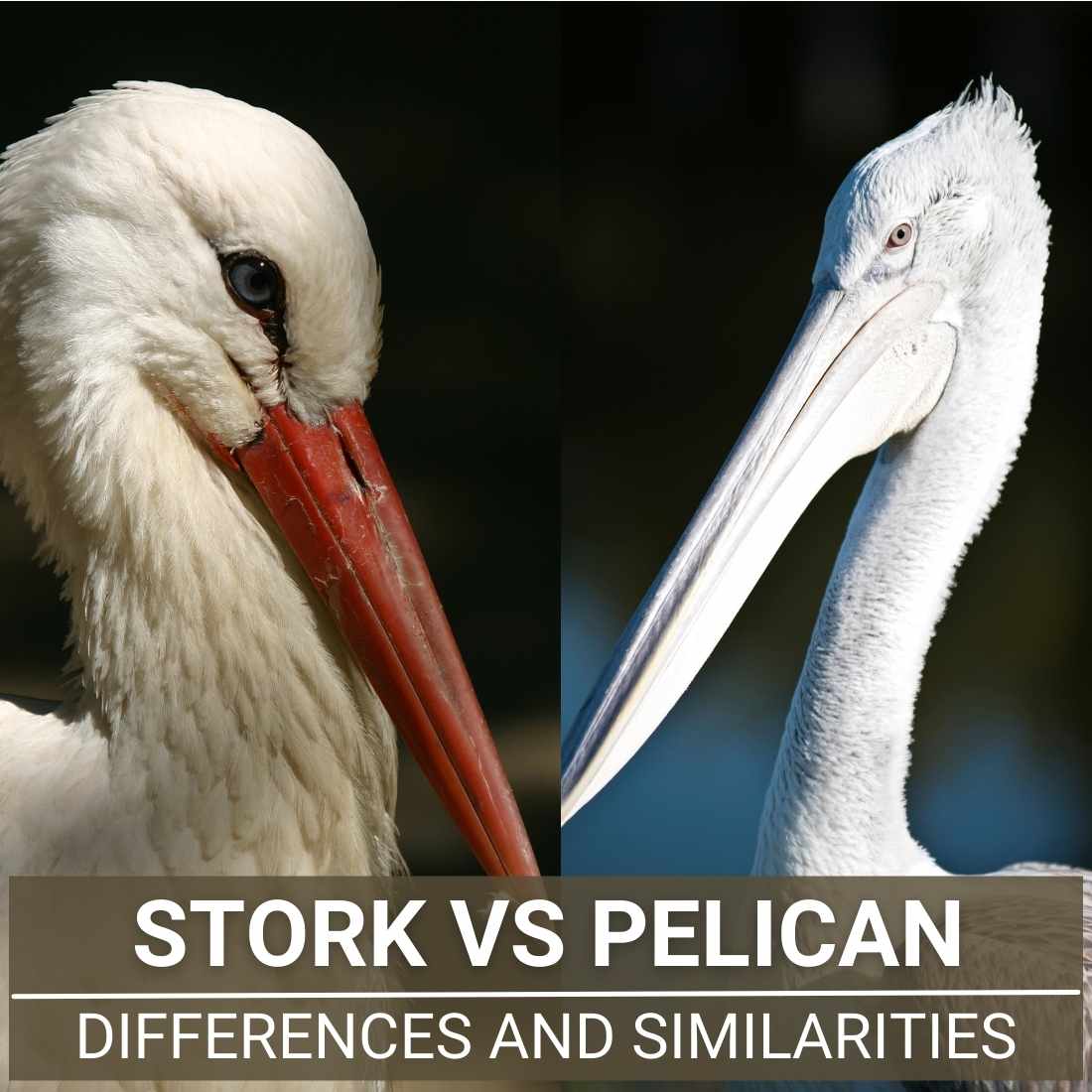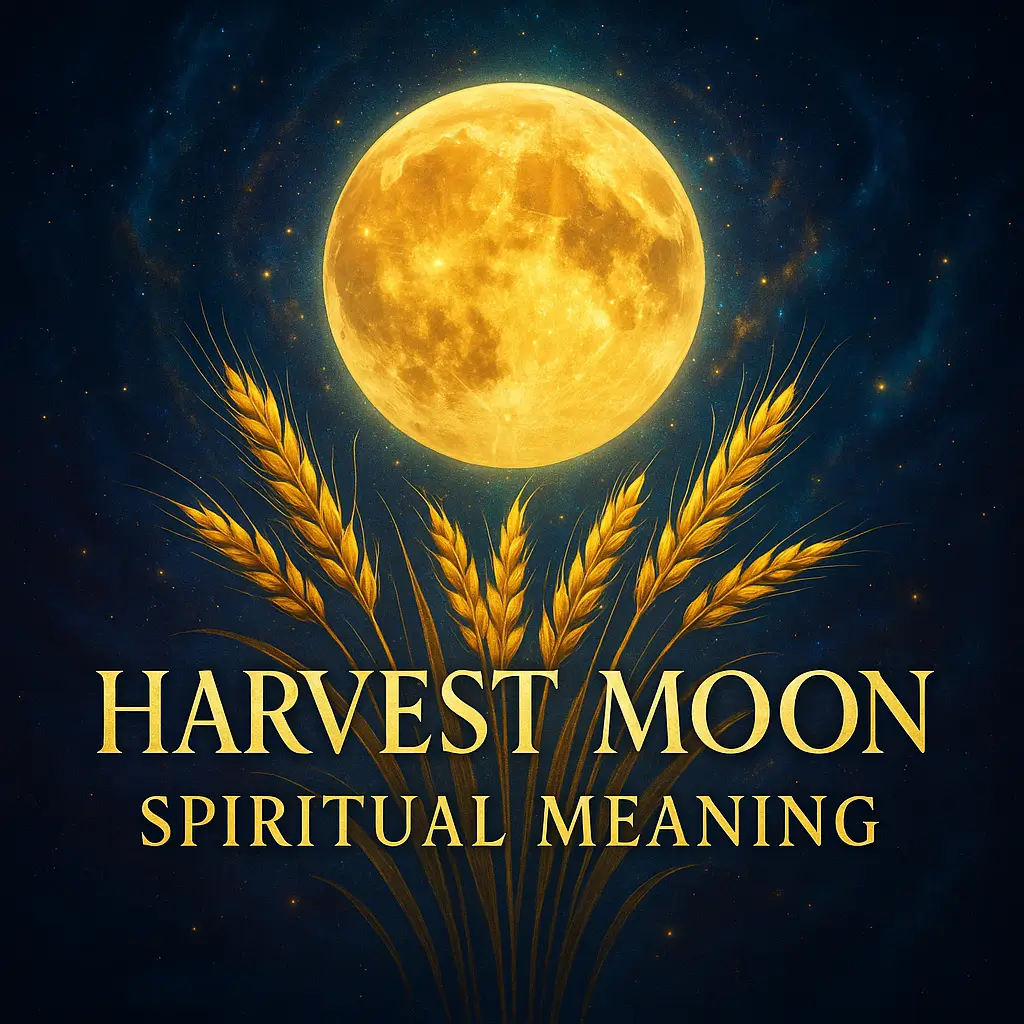Pelicans and Storks are fascinating birds belonging to two separate groups of birds. Both birds have a wide variety of differences in their characters. Nonetheless, both pelicans and storks have huge bodies, yet they both have outstanding flying capabilities. Even though some of the distinctions are visible to even the most untrained eye, it is crucial to recognize and explain them. The purpose of this article/post is to explore all the intriguing differences and similarities between pelicans & storks, along with their interesting facts.
Table of Contents
- 1 Differences between stork and pelican
- 2 Similarities between stork and pelican
- 3 Interesting facts about Pelicans
- 4 Interesting facts about Storks
- 5 Frequently Asked Questions
- 5.1 What is the main difference between a pelican and a stork?
- 5.2 How many species of pelicans and storks exist today?
- 5.3 Why are storks considered mute birds?
- 5.4 What makes pelicans exceptional swimmers compared to storks?
- 5.5 How do pelicans and storks differ in mating behavior?
- 5.6 Which bird has the largest beak among all bird species?
- 5.7 What are the key similarities between pelicans and storks?
- 5.8 How do pelicans hunt compared to storks?
- 5.9 What sounds do pelicans produce if they cannot sing?
- 5.10 How do stork nests compare to their body size?
Differences between stork and pelican
Storks belong to the order Ciconiiformes and have long necks and long legs, whereas pelicans are birds with massive bodies and belong to the order Pelecaniformes. Almost eight species of wild pelicans are still present today, and they are all members of the genus Pelecanus. In fact, fossil evidence indicates that Pelecanus included more than ten species, indicating that it was a very diverse genus.
Similarly, there are 19 known species of storks globally, classified into 6 genera, with the most notable being the Painted, Black-necked, Woolly-necked, Openbills, adjutants, and Marabou. The majority of stork species are migratory birds, as is the case with most other birds. Most pelicans have a wingspread of 1.8 meters, but Dalmatian pelicans may reach up to three meters in length, while the Marabou has the longest wing diameter, which is over 3.2 meters in length.
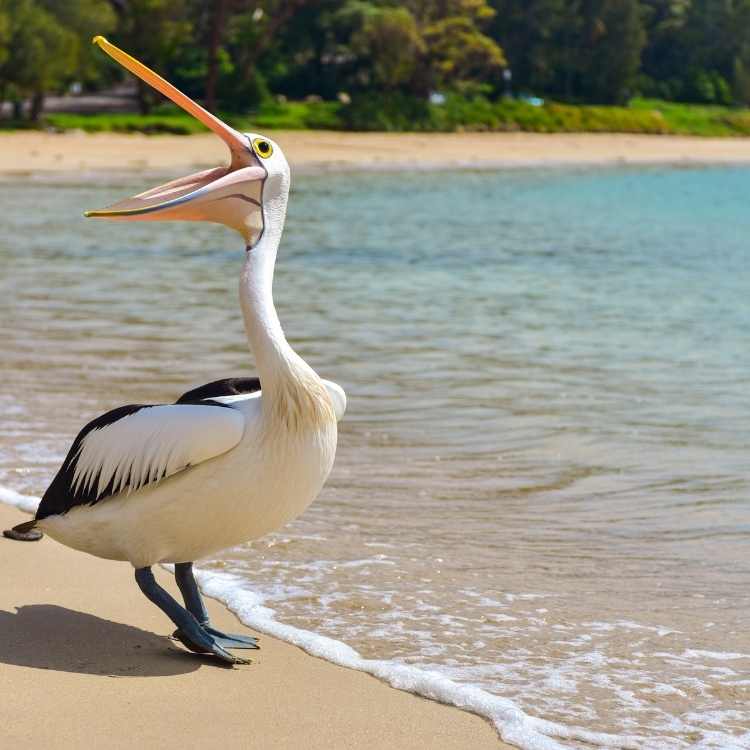
Other noticeable differences between Pelicans & Storks are given in this table:
| Pelicans | Storks |
|---|---|
| Pelicans are bigger and bulkier than storks. | Storks are lighter than shorter than Pelicans. |
| Pelican has short necks as compared to Storks. | Storks have a lengthier neck than pelicans. |
| Less diversity in Pelican species. | Storks have two times more diversity than Pelicans. |
| Pelicans have a distinguishing pouch below their bill. | Storks do not have a pouch in their bill. |
| Pelicans are known to have the largest bill/beak among all the birds. | Stork bills/beaks are also not tiny, but they are not larger than pelicans’ bills, or in other words, they do not compete with Pelicans’ bills. |
| Pelicans usually make sounds (no singing) from their syrinx. | Storks are mute. They never produce any sound. |
| Pelicans have prominent webbed toes. | Storks have slightly webbed toes. |
| Pelicans change their partner often. They stay with their sexual partners only for 1 breeding season. | Storks are loyal birds, and they spend their whole life with the same partners. They do not change their partner in every breeding season, as Pelicans do. |
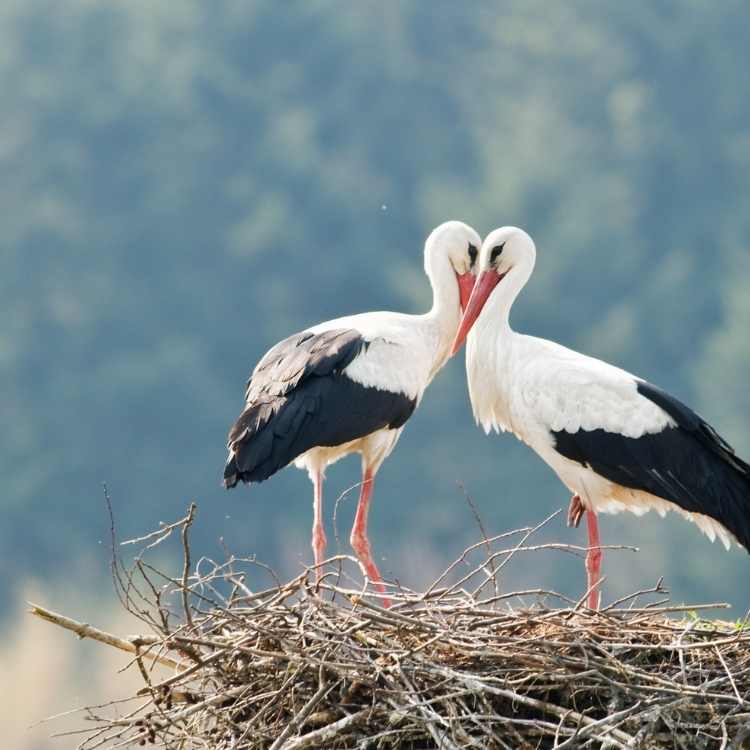
Similarities between stork and pelican
Pelicans and storks are two beautiful wild birds that can fly at great heights and for extended periods of time. They have exceptional adaptations for long-distance flight, as seen by their huge and broad wings, which are also quite strong in nature.
They are a large-bodied bird species that are on the verge of extinction. Both of them are mute/silent, and people have created intriguing mythology about them throughout the years, despite the fact that such legends are attributions to their way of living. Both pelicans and storks have a long neck (we also have a list of long neck birds) and a long beak, which is characteristic of their species. White with black patterns is the standard coloring for each of them.
Interesting facts about Pelicans
One of the Pelican species, the Dalmatian pelican, has the biggest beak of any bird in the World. Pelican tail is relatively square in shape and shorter in length. Pelicans have powerful legs and full-webbed toes, which makes them good swimmers. Pelican nesting may be divided into two categories: those that nest on the floor/ground (such as the Australian Pelicans, Dalmatian Pelicans, Great White Pelicans, and American White Pelicans) and those that nest in trees (such as the Pink-backed Pelicans, Spot-billed Pelicans, Brown Pelicans, and Peruvian Pelicans).

The majority of pelicans do not dive bomb their prey; instead, they scoop it up while treading along the surface of the water. To boost their chances of success, the birds occasionally organize hunting parties, assembling in a U-shape and pounding their wings on the water to corral fish into a compact cluster—or force them into the shallows—to increase their chances of catching more fish.
Other noteworthy facts are as follows:
- Pelican sexual partners only spend time together at a particular breeding season and in a specific geographical location. After one season, they usually change their partner.
- The flight of the pelican is beautiful and powerful, with heavy wings.
- Pelican cries are usually croaks and grumbles. These birds are not known for beautiful singing because they have a modified syrinx that only allows them to make a few noises.
- Read more about the pelican symbolism.
Here you can check all Pelican sounds
Interesting facts about Storks
Among the noteworthy characteristics of these birds is the lack of syrinx muscles along with a vocal gland (that is poorly developed), which has resulted in their silent behavior or muteness. They can, however, generate noises by snapping their powerful bills together. Storks create massive nests. The diameter of some nests has been measured to be more than two meters (six feet) in diameter and around three meters (ten feet) in depth.
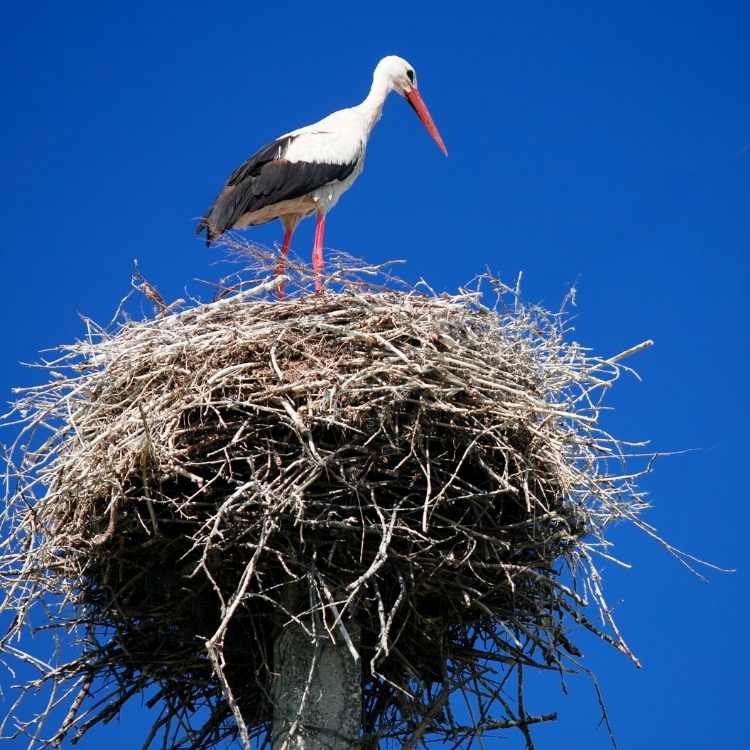
They build their nests for long-term use, demonstrating that they are sedentary birds.
When stork chicks hatch, they are nearly naked, but they rapidly grow a coat of soft down feathers to shield them from the harsh environment. Being altricial and in need of parental care, both parents are kept occupied flying back and forth to provide meals to them on a regular basis. Chicks may consume up to 60 percent of their own body weight in a single feeding session.
Read also about the stork symbolism.
Other facts to consider are as follows:
- Storks are Old World wading birds with usually white and black plumage.
- Storks frequently employ leaping and gliding flight to preserve their energy when traveling over vast distances.
- Their diet may include tiny frogs, earthworms, small to medium-sized fish, and even any other small animals.
- The average Stork female lays between 2 and 5 eggs every cycle. The incubation period is between 25 and 35 days.
Here you can check all Storks sounds
In another post, we also compared the stork to the crane: Stork vs Crane.
Frequently Asked Questions
What is the main difference between a pelican and a stork?
Pelicans belong to order Pelecaniformes with massive bodies and short necks, while storks belong to Ciconiiformes with long necks and long legs. Pelicans have a distinctive pouch below their bill, whereas storks lack this feature entirely.
How many species of pelicans and storks exist today?
Approximately eight wild pelican species exist today within genus Pelecanus, while 19 stork species are classified into six genera globally. Fossil evidence suggests pelicans were historically more diverse with over ten species.
Why are storks considered mute birds?
Storks lack syrinx muscles and have poorly developed vocal glands, preventing them from producing typical bird sounds. However, they generate noise by snapping their powerful bills together forcefully.
What makes pelicans exceptional swimmers compared to storks?
Pelicans possess powerful legs with fully webbed toes, enabling superior swimming abilities. Storks have only slightly webbed toes, making them less adapted for aquatic hunting compared to pelicans.
How do pelicans and storks differ in mating behavior?
Pelicans change partners every breeding season, staying with mates only for one season. Storks are monogamous and remain with the same partner throughout their entire lives, demonstrating lifelong loyalty.
Which bird has the largest beak among all bird species?
The Dalmatian pelican possesses the largest beak of any bird worldwide. Most pelicans have wingspans reaching 1.8 meters, while Dalmatian pelicans extend up to three meters in length.
What are the key similarities between pelicans and storks?
Both have massive bodies, exceptional long-distance flying capabilities with broad wings, long necks and beaks, and typically white plumage with black patterns. Both species are considered endangered and have fascinating cultural mythology.
How do pelicans hunt compared to storks?
Pelicans scoop prey while treading water surfaces, often organizing group hunts in U-formations to corral fish. Storks feed on frogs, earthworms, small fish, and animals by wading and using soaring flight to preserve energy.
What sounds do pelicans produce if they cannot sing?
Pelicans emit croaks and grumbles from their modified syrinx, which only allows limited vocalizations. They lack the vocal capabilities for beautiful singing despite possessing sound-producing mechanisms unlike silent storks.
How do stork nests compare to their body size?
Storks construct massive nests exceeding two meters in diameter and three meters in depth, built for long-term reuse. These permanent structures demonstrate their sedentary nature and commitment to specific breeding territories year after year.
